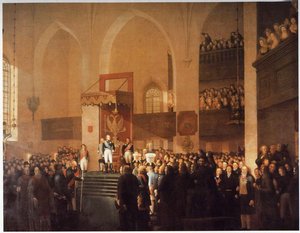Diet of Finland
|
|
The Diet of Finland, Suomen valtiopäivät or Finlands Lantdag, was the legislative assembly, and successor to the Riksdag of the Estates, of the Grand Duchy of Finland from 1809 to 1906.
| Contents |
The Porvoo Diet
During the Finnish War between Sweden and Russia, the four Estates of occupied Finland (Nobility, Clergy, Burghers and Peasants) were assembled at Porvoo (Borgå) by Tsar Alexander I, the new Grand Duke of Finland, between March 25 and July 19, 1809. The central event at Porvoo was the sovereign pledge and the oaths of the Estates in Porvoo Cathedral on March 29. Each of the Estates swore their oaths of allegiance, committing themselves to accepting the Emperor and Grand Duke of Finland as the true authority, and to keeping the constitution and the form of government unchanged. Alexander I subsequently promised to govern Finland in accordance with its laws. This was thought to essentially mean that the emperor confirmed the Swedish Instrument of Government from 1772 as the constitution of Finland, although it was also interpreted to mean respecting the existing codes and statutes. The diet had required that it would be convened again after the Finnish War, which separated Finland from Sweden, had been concluded. On September 17 of the same year, the conflict was settled by the Treaty of Fredrikshamn, but it would be another five decades until the Finnish Estates would be called again.
The Estates convene again
Not until June 1863, after the Crimean War had taken place, did Alexander II call the Estates again. On September 18 the opening ceremony was held and the Emperor made his declaration where he promised to introduce changes to the constitution. The changes included making the diet a regularly convening body, a promise which was kept by the Emperor when the diet convened again in January 1867, where it established an act on the working order of the diet. The diet was to convene at least every fifth year but in practise it would come to convene every third year. The act on Freedom of the Press was seen to have been rejected by the diet in 1867, and as a consequence censorship was introduced. The diets of the 1860s created a working and regularly convening Finnish parliament, but it also spelled an end to further promised constitutional reforms.
In the elections for the diet of 1872, members of the two language-based parties, the Fennomans and Svekomans, gained more ground at the expense of the liberals. After the assassination of Alexander II the special position of Finland in the Russian empire was in danger. Alexander III announced that the Finnish monetary, customs and postal systems were to be incorporated into their imperial counterparts. At the diet of 1882 the Governor-General gave the Emperors announcement that the diet would have the right to submit bills, but he would be the only one to initiate changes regarding the constitution and military issues.
The first period of oppression
In 1899 Emperor Nicholas II signed, what was come to be known as the February Manifesto. The powers of the diet regarding Finland's internal affairs were weakened and transferred to the Russian ministers. The legal committee of the diet of 1899 adopted the opinion that the manifesto was not legally valid in Finland.
Reform
The unrest during the Russo-Japanese war resulted in a great strike in Finland in October 1905. The most immediate result was the Emperor's manifesto that cancelled all illegal regulations. A parliament based on universal and equal suffrage was also promised. An extraordinary session of the diet in December 1905 was called to implement the parliamentary reforms. The proposal was presented to the Emperor on 15 March 1906 and after his approval it was submitted to the estates on 9 May. The reforms came to force on 1 October 1906. The diet was reformed from a legislative assembly of four Estates into a unicameral parliament of 200 members. At the same time universal suffrage was introduced, which gave all men and women, 24 years or older, the right to vote. Acts on the right of parliament to monitor members of the government, on the Freedom of Speech, Assembly and Association, and Freedom of the Press were also introduced. These reforms established the hallmarks of today's Parliament of Finland.
See also
External links
- History of the Finnish Parliament (http://www.eduskunta.fi/fakta/historia/eng/index_1.htm) - Official site
- Kejsarens tal vid lantdagens avslutande den 19 juli 1809 (http://sources.wikipedia.org/wiki/Kejsarens_tal_vid_lantdagens_avslutande_den_19_juli_1809) - in Swedish at Wikisourcefi:Porvoon maapäivät

